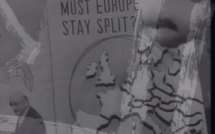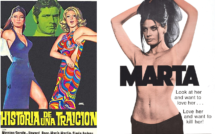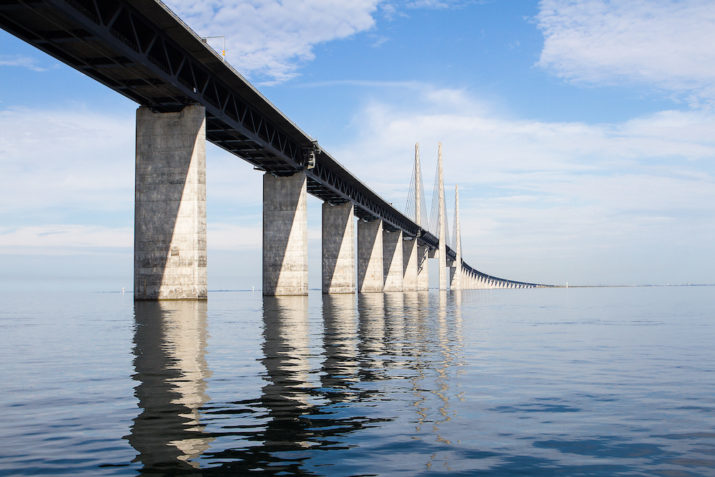
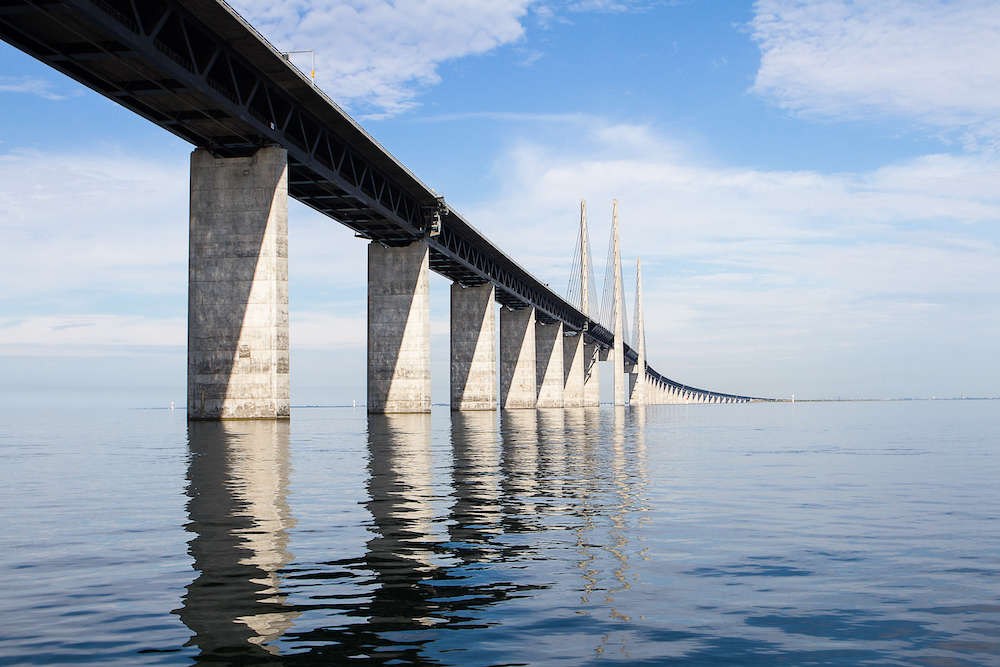
This is part of our special feature on European Culture and the Moving Image.
In recent years, borders and borderland settings have proliferated in European television, arguably making the “border series” a category of its own.[1] HBO Europe’s Polish series Wataha (2014-) was translated as The Border for its 2016 UK release. Reviewing the series for its UK television premier just before the Brexit referendum, The Guardian TV critic Mark Lawson mused that the show is “probably too nuanced and niche to have much sway” on the vote. French author Geraldine Schwarz, winner of the 2018 European Book Award, forwarded a similar idea about the narrative potential of series when she expressed regret that there is no collective feeling of belonging that binds the EU. Schwarz suggested that perhaps “we need a Netflix series about Europe?”[2] As both commentators submit, TV series in general might offer complex and valuable insights into heated debates about Europe’s borders and may hold the potential to reach and influence a significant audience. In other words, series can be both nuanced and popular.
Film scholars have long-observed cinema’s capacity for reflecting on Europe’s “question of space” and the European Union’s recent transformations and realignments.[3] Cinema as art and industry helps to define the highly contested idea of what Europe signifies in a post-1989 landscape. So far, less has been said about the role of TV dramas in delineating and defining the ideational contours of Europe. Series recount the evolving story of Europe. When looked at collectively, as part of a production and distribution ecosystem, due to their popularity, series can tell us what (as a community of viewers and citizens) we think about borders. This requires reading on-screen elements and what goes into funding, making, and distributing series and understanding the feedback loops (fueled by algorithms and ratings) that contribute to the reproduction of certain narrative strands and aesthetic approaches.
European TV: unity in diversity and a shared “noir” template
Aside from a handful of examples at the geographic extremities of Europe, the vast majority of border series are set near or across much less politically significant and symbolically charged internal EU borders. These border representations come in a variety of forms, but many offer similar representations of sylvan borderlands that are notably set within, not on the outer limits, of the continent. It seems that images and imaginations of fraught border zones linger on screen despite more than twenty-five years of open interior borders. There may not be a popular and influential “series about Europe” like the one Geraldine Schwartz evoked, but Europe is rife with series made in the past decade from different corners of the continent with common visions of borders.
If there are few “series about Europe,” the “European” quality of series lies in a certain brand of narrative “unity in diversity.”[4] The formula for this—local stories with a sense of place that are universal enough to travel—has been adopted both by HBO and Netflix.[5] The Franco-German broadcaster Arte takes a slightly different angle, aiming to craft stories that are French but “less French” so as to appeal to wider European audiences.[6] Productions commonly grouped under the umbrella term “Nordic Noir” are at the origins of the widely replicated template for the standards of European ‘quality television.’[7] “Nordic Noir” series are notable for their construction around an “intense sense of place.” The immensely influential productions from Denmark and Sweden such as such as Forbrydelsen/The Killing (2007-2012) and Bron/Broen/The Bridge (2011-2018) —an archetypal border series—frame Nordic landscapes on a distinctively cinematic scale. Wide angles and foreboding aerial shots frame bleak postindustrial settings and stark, generally wooded vistas dominated by understated and monochromatic color palettes, often producing an eerie and frigid atmosphere.[8] Some version of this template has been applied to a diverse range of European locales.[9] The narrative strategies of many of the border series that I address here also owe a great deal to Nordic Noir, which innovated and popularized a “double storytelling” approach in which crime becomes a vehicle to simultaneously explore wider personal and social dramas and anxieties.[10] Many border series fall broadly within the crime genre category, an enduringly popular format and eminently adaptable template for approaching contemporary social issues and anxieties.[11] It is no surprise that crime drama, particularly the strand labeled “Nordic Noir,” has proven an effective way to tell stories about borders, arguably Europe’s most enduring and pressing contemporary anxiety. The mobility, adaptability, and appeal of the Nordic Noir template across Europe is an inevitable starting point for my discussion of contemporary European border series because it points to the appeal of shared European (and to some extent, global) narratives that are simultaneously anchored in place and universal.[12]
Categorizing the European border series: networks, forests, time travel, and migrants
European border series fit into four primary and sometimes overlapping groups: networked borders, forested borderlands, temporal borders, and migration-focused narratives. The most prominent category involves energy and transportation infrastructure and information networks. The Bridge, the aforementioned ur-infrastructure series, focuses on a specific borderline that has been augmented by technology and human intervention. The show opens with a murder on the midpoint of the Øresund Bridge, which opened in 2000 and connects Denmark and Sweden by road and rail. This model involves a parallel transnational narrative and a corresponding production endeavor, and has been adapted to two other European border settings. The lifespan of the UK/France adaptation, The Tunnel/Tunnel (2013-2018, UK/France), encompasses pre- and post-Brexit referendum in its three seasons over the course of five years that corresponded to an increasingly fraught period marked by turmoil and border anxieties. It thus demonstrates how recurring series have the advantage of evolving and responding to changing outlooks and new events such as anti-austerity protests; the popularity of far right politicians and platforms; terrorism; and the refugee crisis, exemplified by a burned boat with trafficked children from Syria. As one reviewer put it, The Tunnel “is engaging with the story in Europe right now: the refugee crisis” (my emphasis).[13] The subsequent German-Austrian remake, Der Pass/Pagan Peak (2018-), also adapts to reflect the times, opening with a dead Bulgarian human smuggler and refugees who perished on a truck near the highway border. Pagan Peak is also notable for how it adapts the spatial dynamic from focus on infrastructure to a wooded borderland setting that has become so prevalent in European series.
The networked border narratives in series such as Pustina/Wasteland (Czech Republic, 2016–), Midnattssol/Jour Polaire/Midnight Sun (France/Sweden, 2016-), and Okkupert/Occupied (Norway/France/Germany, 2015-) are not primarily set on geographic borders. However, connections and crossings are both implicitly and explicitly central. These series map a Europe linked by what Randall Halle theorizes as “interzones,” post-national spaces of “contact and transfer” that involve complex interactions between infrastructure natural boundaries, border stops, mental maps and visual media.[14] In these series, networks of European connectivity are often premised on movement of energy resources such as pipelines. Occupied tells the story of an EU-endorsed Russian invasion of Norway in the near future as a response to that nation’s decision to halt fossil fuel production. With recurring images of pipelines leading to the EU and Russians infiltrating the national space via the remote northern border, Occupied underscores the infrastructure and networks that contribute to connections across borders. Hackerville (Germany/Romania) offers a twist on this with a virtual network that implicates financial institutions but is also highly attuned to the historical context of borderlands and border crossings in Europe.[15] The dramatic transformation of place, whether in the form of new infrastructure or the destruction of existing places of habitation, is a recurring subtext in numerous border series. Midnight Sun is set in a town that is slated to be moved to counteract damage from mining. Similarly, the Czech drama Wasteland, sets the story of a murder in a village near the Polish border in eastern Bohemia that is on the brink of extinction.[16]
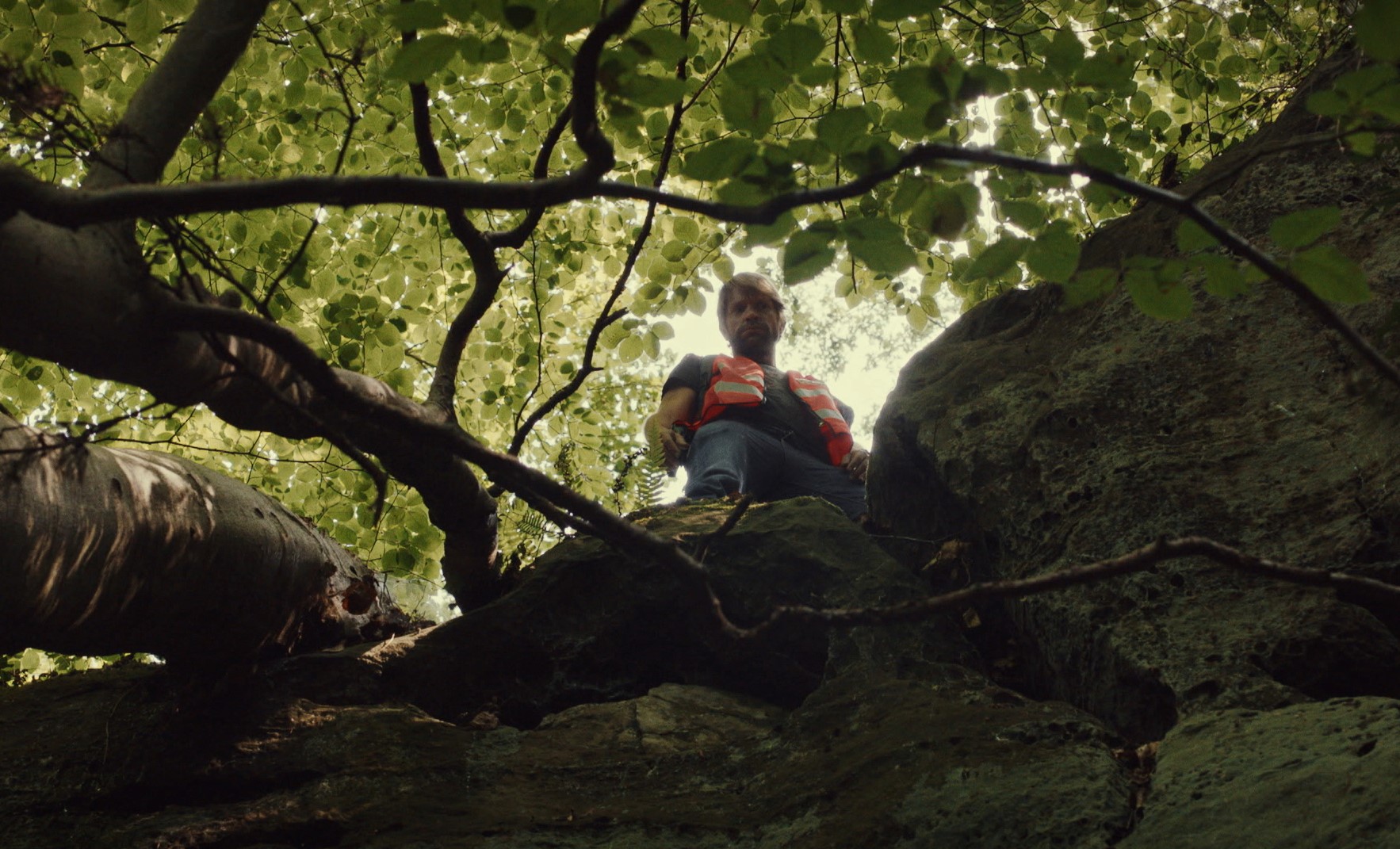
The second category, forested borderland series, might seem less expected but has become widespread and offers fascinating insights into European outlooks on borders.[17] In these series, the forest setting represents ancient and contemporary anxieties about alterity, the unknown, and various generally nefarious, frightening, and illicit activities. Borders are often explicitly represented and sometimes engaged with indirectly in these series. In Borderliner (Norway, 2017-), Sorjonen/Bordertown (Finland, 2016-2020), Glacé/The Frozen Dead (France, 2016-), Capitani (Luxembourg, 2019-), Djavolskoto Garlo/Devil’s Throat (Bulgaria 2019-) and the aforementioned Pagan Peak and The Border, proximity to the physical border becomes an important plot element. In other series, the border looms large but is not explicitly shown. For instance, La Trève/The Break (Belgium, 2016-) is set in Wallonia near the borders with Germany and Luxembourg as well as the internal border with Flanders. The Break explores this border zone as a narrative site of racial violence, smuggling, and fights over resources and terrain without showing actual border crossing.[18] Zone Blanche/Black Spot (France/Belgium, 2017-), set in an isolated fictional town in the heart of the Vosges Mountains near the Swiss and German borders, offers a historical and fantasy twist. The wooded borderland in Black Spot becomes a symbolic locus of various menaces and a fight over nature and resources. The series adds a supernatural element inspired by Celtic tradition (earning the term “Celtic Noir” in the French media).[19]
What is perhaps most remarkable about the prevalence of the forested borderland setting in European series is that it often transposes narratives about external borders—like those in the Polish The Border and Bulgarian Devil’s Throat—onto internal borders between Schengen zone nations. The Border is not the first forest border series, but it does represent the archetype for this category that project a variety of bad things and sources of societal anxieties onto dark, wooded realms. Set on the Eastern frontier of the EU and of the Schengen Zone along the border between Poland and Ukraine, it follows the inner working of the Polish Border Guard and explores the complexities that define the region’s mountainous borderlands. The series depicts the integrity of the border as under constant pressure from outside forces such as smugglers and clandestine migrants from Chechnya and other points east. However, this highly nuanced series does not present the border in binary terms as a division between good and bad. Indeed while “the border” as a political, social, and economic entity dominates the concerns of the everyone in the series, the recurring image of the physical border line is in comparison extraordinarily banal: a small post in the middle of a field of tall grasses demarcates the ostensible outer limit of Europe.
Temporal borders and migrant narratives, the final two categories, are much smaller but are nonetheless notable. In the HBO Nordic production Beforeigners (Norway, 2019-) Oslo harbor becomes the setting for the arrival of migrants of the temporal variety, from the nineteenth century to Viking times. The investigation by the police of the murder of a female time traveler is the starting point for Beforeigner’s novel approach to the archetypal Nordic Noir “double-storytelling” model. The arrival by sea via temporal migration creates an unmistakable resonance with the contemporary refugee crisis in the Mediterranean, and the treatment of the old newcomers by contemporary society clearly encourages viewers to consider their own stance towards immigrants. Beforeigners could also be situated within the very small group of series that are primarily focused on migrants. While many of the series discussed above do include plot elements about migration,[20] most are focused primarily on those who already inhabit the border spaces in question. There are some notable exceptions to this. The French-German coproduced miniseries Eden (2019) traces several interwoven destinies from Greece to Calais via Frankfurt and Paris. The Irish drama Taken Down (2018-) explores the world of asylum seekers caught in seemingly endless limbo in that nation’s Direct Provision housing system. Another example is the UK comedy-drama Home (2019-2020), about a refugee who slips into Britain in the back of a family car returning from vacation.
Crossing lines: creating and distributing European border series
No discussion of borders in European screen media is complete without accounting for the processes and apparatuses that finance, create, and distribute the narratives that we see on screen. The creation of border series and “quality television” programming in general fits into Europe’s tradition of Public Service Broadcasting and to commercial broadcasters producing quality television drama for prime time.[21] The recent addition of global streaming giants such as HBO, Amazon, and Netflix to other regional and national platforms (Canal +, Movistar +, Sky) has accelerated the rapid spread of these productions and narratives across borders.[22]
A detailed examination of production contexts is beyond the scope of this article, but it is useful to keep two key points in mind. First, many transnationally co-produced series are much more than financial arrangements and represent close creative collaboration across borders.[23] Second, beyond the financial incentive for making series, there is also an ideological impetus. The EU, most recently through the Creative Europe initiative, has promoted the “ambitious attempt to bring a rather fragmented European culture closer together, and to ensure that all creative forces across national borders are harnessed to bring stories and other cultural products to a wider European audience.”[24] Infrastructure is provided by the Creative Europe television co-production initiative, which requires participation of at least three European broadcasters,[25] and the Séries Mania industry forum, which aims to develop European TV drama to compete with US productions.[26]
As media commodities, series exhibit mobility across borders of popular narrative tropes that express widespread, shared border anxieties. It is clear that a certain brand of border narrative outlined in the above summaries travels well because it has popular currency in Europe. Series are well suited to do so because they are by design—and necessity—aimed at a large audience and therefore reflect and re-produce common narratives of identity. Europeans watch on average 2.5 hours of TV[27] and many of these series enjoy audiences that number millions of viewers. European series, to a greater degree than European film, are driven by fundamentally economic imperatives. This does not mean that series production is based solely on financial factors. Indeed, public service broadcasters, particularly in Nordic countries, have played an essential role,[28] first by creating influential content and then through co-productions with commercial broadcasters with similar values such as Canal +.[29] Many series are produced by a “loose-knit title-by-title European alliance” that comprises both public and private broadcasters and similar approaches to storytelling that crosses cultural and national boundaries.[30] While multinational platforms and content creators such as HBO and Netflix have different missions than their public service counterparts, they have (to different degrees) sought to cultivate their brands and draw subscribers by making or distributing local series on par with European standards of quality television.[31]
Adaptations such as from The Bridge to The Tunnel and Pagan Peak involve a transformation of the story to another geographic and cultural context, but also a very different creative process and method of collaboration.[32]The Bridge was a Danish-Swedish creative co-production commissioned by public-service broadcasters in those nations and received funding from public-service broadcasters in Germany and Norway.[33] The Tunnel, by contrast, was a private initiative, co-produced for Sky TV in Britain and Canal+ in France. Private-public co-production partnerships are also common. For instance, Canal+ made Midnight Sun with Swedish public broadcaster SVT. Occupied was made for commercial TV2 in Norway in collaboration with Arte, the Franco-German broadcaster with separate production branches in France and Germany that bills itself as “The European Culture Channel.” Since this inaugural European co-production for the transnational broadcaster, Arte has since partnered with broadcasters and producers in The Czech Republic, Poland, Denmark, Italy, and Spain. The Break demonstrates another common model; made for French-language Belgian broadcaster RTBF with the cooperation of mobile telecommunications company Proximus, the series is technically the production of just one language community within a larger nation but clearly draws inspiration from transnational tropes, narratives, and visual elements. The widespread appeal of this template is demonstrated by the acquisition of the series by Netflix for global distribution. HBO series such as Beforeigners, Hackerville, and Wasteland follow a different path. Made with global funding and know-how, these series nonetheless are the result of significant local control[34] and artistic vision and were directed by acclaimed local filmmakers Jens Lien, Igor Cobileanski, and Alice Nellis, respectively.
Conclusion: mapping and European border series
The transnational funding and production backstories outlined above are clearly a key element in the proliferation of border-crossing narratives. Border series also travel readily across Europe because of their on-screen attributes. The prevalence of maps and mapping in border series offers an important clue about why these series are proliferating in Europe. From detectives struggling to orient themselves with traditional paper maps (The Tunnel) to migrants straining to track their coordinates using GPS while enclosed in the back of a truck (Eden) and a multitude of symbolic maps on walls, border series are replete with references to and gesture of cartography. The mapping function of series that is encoded within narratives is further evinced by the fashion in which series are often marketed. Adopting a “cartographic marketing” approach, UK-based Arrow TV used a European map-based trailer to advertise its “Nordic Noir and Beyond” collection,[35] suggesting that by watching series from diverse locations on the continent, one might better understand how it all fits together. HBO Europe distributed paper maps of the borderland setting of The Border in which the main protagonist’s head is superimposed over a map of the region, inviting us to consider the intersection of on-screen narratives and mapping in the (re)production of borders and the discourses that circulate about them. The question of European space and how it is demarcated has become particularly salient in the twenty-first century, and Europe’s boundaries are still “unfinished” as French geographer Michel Foucher puts it.[36] In this context, it is clear that border series respond to a common and ongoing impulse among European viewers to update their mental maps and reimagine their place in the world. Viewing TV about borders inevitably triggers a mapping impulse that situates and re-situates viewers in relation to the spaces show on screen.
Michael Gott is Associate Professor of Film & Media Studies and French at the University of Cincinnati. His books include French-language Road Cinema: Borders, Diasporas, Migration and “New Europe” and East, West and Centre: Reframing European Cinema Since 1989. This article is related to an ongoing project on film and TV depictions of European borders.
References
Bondebjerg, IB, et al. Transnational European television drama: production, genres and audiences. Cham, Switzerland: Palgrave Macmillan, 2017.
Conley, Tom. Cartographic Cinema. Minneapolis: University of Minnesota Press, 2007.
Creeber, Glenn. “Killing us softly: Investigating the aesthetics, philosophy and influence of Nordic Noir television,” Journal of Popular Television, 3: 1, pp. 21–35, 2015.
Foucher, Michel. 2006. Le retour des frontières. Paris: C.N.R.S. Editions.
Galt, Rosalind, The New European Cinema Redrawing the Map. New York: Columbia University Press, 2006.
Halle, Randall. The Europeanization of Cinema: Interzones and Imaginative Communities. Urbana: University of Illinois Press, 2014.
Hansen, Kim Toft and Waade, Anne Marit. Locating Nordic Noir: From Beck to The Bridge. Cham, Switzerland : Palgrave Macmillan, 2017.
Imre, Aniko. “HBO’s e-EUtopia.” Media Industries 5.2, 2018.
Piper, Paige. “Blood in the snow: Mapping murder in contemporary Nordic/French crime television,” Contemporary French Civilization, 43:1, pp. 17-31, 2018.
Turnbull, Sue. The TV Crime Drama. Edinburgh: Edinburgh University Press, 2014.
[1] Films made about the Mexico-US border and borderlands set in the United Sates offer a useful comparison. In Border Bandits: Hollywood on the Southern Frontier, Camilla Fojas characterizes the Hollywood “border film” as a category that spans “many different genres” and, share similar preoccupations with mobility, trafficking, border porosity (2008, 3).
[2] https://www.franceculture.fr/emissions/la-grande-table-2eme-partie
[3] See Galt 2006, Halle 2014, Liz 2016,and Rivi 2006.
[4] Hansen and Waade 2017 and Imre 2018.
[5] Hansen and Waade 2017.
[6] https://variety.com/2020/tv/global/arte-france-moves-open-up-french-series-international-1203550270/
[7] Creeber 2015, 22
[8] Piper 2018, 19-20
[9] This approach to filming place been imitated and adapted by shows set in places with landscapes comparable to the original Nordic setting, from northern France to the eastern Czech Republic and the Jurassic Coast in England. In an effort to capture the success of Nordic Noir, it has also been translated to seemingly incompatible locales as far afield from the Nordic states as Almería, on the southern coast of Spain, and the island of El Hierro, the most southwesterly point of Europe.
[10] Creeber 2015, 23
[11] Turnbull 2014, 2
[12] Imre 2018, 62
[13] https://www.theguardian.com/tv-and-radio/2017/dec/15/the-tunnel-vengeance-review-intriguing-sleepover-kid-swap
[14] Halle 2014, 4, 8-9
[15] In Hackerville, the German cybercrimes detective sent to Romania to investigate the hacking of a major German bank is in fact a Romanian who emigrated as a child and the setting in Timișoara is in a historical borderland between the Ottoman Empire and Austria.
[16] The “interzone” reading is particularly apt in Midnight Sun, which involves a French police officer of Algerian Berber origins teaming with a Swedish detective of indigenous Sámi extraction to investigate the murder of a French national in Sweden’s far north. Through this framework of complex and multifaceted post-colonial identities the narrative suggests a variety of links and affinities between Lapland and the Mediterranean.
[17] Forest settings are of course not uniquely associated with border narratives and encompass fantasy and quest genres as well as the crime dramas discussed here. It is also notable how crime narratives set in the woods have traveled across national industry borders. Notably, the 2014 Norwegian series Øyevitne/Eyewitness which resolves around yet another grizzly forest murder, has been remade as the Romanian series Valea Mutã/Silent Valley (2016) and in France as Les Innocents in 2017. Although only the French version is explicitly set in a border region (in the Pyrenees Mountains and coast near Cerbère), the use of forests as sites of danger and menace in circulating crime series offers some useful context in the present discussion of border series.
[18] http://www.helicotronc.com/latreve
[19] The natural setting as space of connection with folklore and tradition is a theme in Pagan Peak and Die Toten vom Bodensee/Murder by the Lake (2014-), an Austrian-German series set on Lake Constance, which forms a border where those two nations and Switzerland converge.
[20] Most significant in this category are Devil’s Throat, Pagan Peak, The Tunnel, and The Border.
[21] Bondebjerg et al. 2017, 1
[22] https://variety.com/2020/tv/global/arte-france-moves-open-up-french-series-international-1203550270/
[23] Bondebjerg et al. 2017, 6
[24] Bondebjerg et al. 2017, 1
[25] https://ec.europa.eu/programmes/creative-europe/media/television-programming_en
[26] Hansen and Waade 2017, 269
[27] Bondebjerg et al. 2017, 25
[28] Bondebjerg et al. 2017, 1
[29] Hansen and Waade 2017, 286
[30] https://variety.com/2020/tv/global/arte-france-moves-open-up-french-series-international-1203550270/
[31] Imre 2018, 59
[32] Bondebjerg et al. 2017, 9
[33] Hansen and Waade 2017, 272
[34] Imre 2018, 50
[35] Hansen and Waade 2017, 5
[36] Foucher 2016, 37

